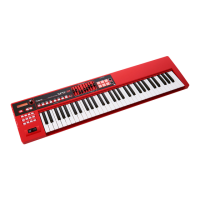25
Editing Sounds
Editing Patch Settings (PATCH EDIT)
1. Use the tone buttons to select the patch that you want to
edit.
2. Press the [MENU] button.
The Menu screen appears.
3. Use the CURSOR [
K
] [
J
] buttons to select “PATCH EDIT,”
and press the [ENTER] button.
PATCH EDIT:
Level : 127
. Use the CURSOR [
K
] [
J
] buttons to switch between parameters, and
use the VALUE [-] [+] buttons to edit the value.
. For a Drum Kit, only the level can be edited.
MEMO
If you’re playing a single sound, you can press [SHIFT] + CURSOR [
J
]
button to access the Patch Edit screen.
Patch parameter
Parameter
CURSOR [
K
] [
J
]
Value
VALUE [-] [+]
Explanation
LEVEL 0–127 Species the volume of the patch.
OCTAVE SHIFT -3–3 Changes the pitch in steps of one octave.
PORTA SWITCH
(PORTAMENTO
SWITCH)
OFF, ON
Species whether the portamento eect
will be applied (ON) or not (OFF).
* Portamento is an eect which
smoothly changes the pitch from the
rst-played key to the next-played key.
By applying portamento when the
MONO/POLY is “MONO,” you can
simulate slide performance techniques
on a violin or similar instrument.
PORTA TIME
(PORTAMENTO
TIME)
0–127
When portamento is used, this species
the time over which the pitch will change.
Higher settings will cause the pitch
change to the next note to take more
time.
MONO/POLY MONO, POLY
Species whether the patch will play
polyphonically (POLY) or monophonically
(MONO).
The “MONO” setting is eective when
playing a solo instrument patch such as
sax or ute.
MONO :
Only the last-played note will sound.
POLY :
Two or more notes can be played
simultaneously.
BEND RNG UP
(BEND RANGE
UP)
0–+48
Species the degree of pitch change in
semitones when the pitch bend lever is all
the way right.
For example if this is set to “+12” and you
move the pitch bend lever all the way to
the right, the pitch will rise one octave.
BEND RNG DN
(BEND RANGE
DOWN)
0–-48
Species the degree of pitch change in
semitones when the pitch bend lever is all
the way left.
For example if this is set to “-48” and you
move the pitch bend lever all the way to
the left, the pitch will fall 4 octaves.
4. Press the [EXIT] button to exit the edit screen.
NOTE
Changes you make are temporary, and are discarded if you turn o the
power or select another sound.
If you want to keep the changes you made, save the settings (p. 27).
Editing Performance Settings
(PERFORMANCE EDIT)
1. Press the [PERFORM] button, and select the performance
that you want to edit or select 016: Init Perform.
2. Press the [MENU] button.
The Menu screen appears.
3. Use the CURSOR [
K
] [
J
] buttons to select “PERFORM EDIT,”
and press the [ENTER] button.
PERF EDIT: PART1
PATCH NO : Pf001
. The upper line shows the part that you’re editing.
Use the [SHIFT] + CURSOR [
K
] [
J
] buttons to switch between parts.
. The lower line shows the parameter that you’re editing. Use the
CURSOR [
K
] [
J
] buttons to switch between parameters, and use the
VALUE [-] [+] buttons to edit the value.
MEMO
You can use [SHIFT] + CURSOR [
J
] button to access the edit screen. This
takes you to the Perform Edit screen if the cursor is located at the
Perform number in the screen, or to the Patch Edit screen if the cursor is
located at the Patch number.
Performance parameter (In the case of SPLIT/DUAL, only parts 1 and 2)
Part
[SHIFT] +
CURSOR [
K
] [
J
]
Parameter
CURSOR [
K
] [
J
]
Value
VALUE [-] [+]
Explanation
1–16
PATCH NO
(Patch No)
—
Number of the patch that’s
assigned to each part
LEVEL 0–127
Volume of each part
You’ll mainly use this to adjust
the volume balance between
parts.
KBD SWITCH
(Keyboard
switch) (*1)
OFF, ON
Turns on/o each part’s
connection between the
controller section and the
internal sound engine
RANGE
LOWER
(Keyboard
Range Lower)
(*1)
C-1–
(UPPER)
Lowest key of the range
sounded by each part
RANGE UPPER
(Keyboard
Range Upper)
(*1)
(LOWER)–
G9
Highest key of the range
sounded by each part
OCTAVE SHIFT -3–3
Shifts the keyboard pitch range
of each part in one-octave
units.
OUTPUT
ASGN (PART
OUTPUT
ASSIGN) (*1)
MFX1–3,
L+R
Output destination for each
part’s original sound
MFX1–3:
Choose form MFX1–3 as
the output destination
L+R:
Output via OUTPUT
without passing through
MFX1
VIB RATE
(VIBRATO
RATE)
-64–+63 Vibrato rate of each part
VIB DEPTH
(VIBRATO
DEPTH)
-64–+63 Vibrato depth of each part
VIB DELAY
(VIBRATO
DELAY)
-64–+63
Time until vibrato is applied to
each part

